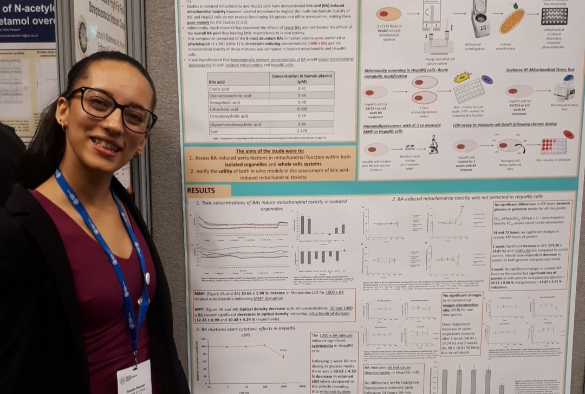Becoming an Expert: Studying drug-induced liver injury
Published on

Sophie Penman is a 3rd Year PhD student at the University’s MRC Centre for Drug Safety Science. Her PhD is an MRC Industrial CASE Studentship with Servier.
Adverse drug reactions
Scientists try to detect the ability of a drug to cause an adverse effect as early as possible during its development, as detection following drug approval is a major concern for patient health. A large proportion of these adverse effects occur in the liver.
Drug-induced liver injury
My PhD is entitled ‘Towards improved models for the study of the multi-mechanistic toxicity of drug-induced liver injury’. By ‘models’ I do not mean the “lights, camera, action” type - models are what we conduct our laboratory tests on and can include isolated organelles, cells, or tissue. It is essential that researchers conduct their experiments using appropriate models, otherwise results that are incorrect, exaggerated or lack applicability to humans can be generated.
Mitochondria are small structures found within our cells that are responsible for generating energy. In fact, 50% of drugs that cause adverse effects of the liver are associated with mitochondrial dysfunction. My research group is particularly interested in using different models to gain a better understanding of the role of the mitochondria in drug-induced liver injury (DILI).
My research
For the first two years of my PhD, I focused on a particular type of liver injury called drug-induced cholestasis, which occurs when biliary transporters become inhibited by drugs and this leads to a toxic build-up of bile acids within liver cells.
Within the field, it was widely accepted that bile acids exert their toxicity via mitochondrial dysfunction. This conclusion was based upon research using rodent liver cells (hepatocytes) or in a cell line called HepG2 cells. Whilst HepG2 cells are the most common cell line used to investigate mitochondrial dysfunction in DILI, they are not very ‘liver-like’ in comparison with human liver cells.
In my research, I conducted experiments using a novel cell line called HepaRG cells, which are more similar to human liver cells than HepG2 cells. Importantly, I was able to show that mitochondrial dysfunction was not a mechanism of bile acid-induced toxicity, contrary to the accepted understanding based upon data from simpler models (PMID: 31288073).
In the final year of my PhD, I shifted my focus onto understanding why certain individuals may experience DILI over others. We know that not everyone who receives a drug will experience toxicity and so determining what makes these individuals more susceptible to toxicity is paramount for improving drug safety.
Overall, the information gained from my PhD will increase our understanding of the role of the mitochondria in DILI. Additionally, the identification of susceptible individuals has the potential to improve patient care, reduce the health and economic burden associated with DILI and improve patient safety and quality of life.
Outside the lab
I’m pleased to say that whilst lockdown may have stopped lab work, other work has kept me busy. I was involved in a review of the most widely researched repurposed agents in order to identify potential safety considerations using existing information in the context of COVID‐19.
Although I’m still waiting for my PhD viva, I’ve recently started a new job as a Global Clinical Study Manager for GSK, in their global health and infectious disease clinical trials. Unlike my PhD, the role isn’t lab based however, a PhD isn’t just about time spent in the lab. I’ve gained key transferable skills that open up many more avenues outside academia.